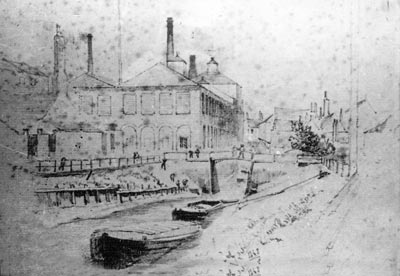 |
Millfleet c.1868 |
|
Kings Lynn
Millfleet Town Mill |
 |
Millfleet c.1868 |
|
Town Mill probably stood at the top of the Millfleet near the almshouses shown in the distance at the centre of the above photograph. The mill was a single storey stone building with the two storey miller's house adjacent and probably stood on the same site as the earlier Swagges Mill. |
The first reference to a mill in this area mentions Sewoldsfled in 1101. It is unclear whether the later name Sunolf's Fleet c.1250, is a corruption of this or associated with the family of Robert fitz Sunolf, first mayor of Lynn. At this time the fleet was known as Mayorsfleet, while the bridge crossing it was called both Mayor's bridge and Sunolf's bridge. Later it was known as Swaggesfleet, after the mill owner and eventally as Millfleet. |
The first mill known on this site was Scales Mill, built by the lord of South Lynn, Lord Scales. It was later known as Swagges Mill but was derelict by the late 1300s. The borough of Lynn acquired the site in 1392 and built a new mill, although it was not a commercial success and the Merchant Gild took it over in 1448. Prior to this, in 1425, a defensive channel connecting Fisherfleet and Purfleet, just outside the town's main defences, was extended to Millfleet to bring more water in to the mill dam from the River Gay. |
Millfleet was strongly tidal and had a relatively small flow of its own water, which meant that the mill was constantly running out of water. A series of new cuts were made to try and provide additional water but when these also failed windmills were built to take over the work. The mill was probably demolished to make way for the London Road in the 1800s. |
A new mill was built on the Gannock, possibly a windmill, occasioned through an insufficiency of water to work the town mill for about this time the "great mill dyke" was recast (1596). |
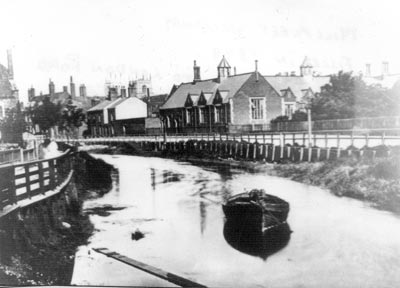 |
Millfleet c.1875 |
Inquest held before the coroners of Lynn on 22 May 1296 into the death of Roger fitz Claricia miller [...] the jurors say that around the middle of the day on 19 May, Roger arose from his midday nap and went down to the water next to the lesser water-wheel of the mill in Lynn called Swargermelne [Millfleet] to wash his hands, when he tripped over himself and fell onto the beam called briggetre. Of which [injury] he languished from that hour until vespers on the following Monday. |
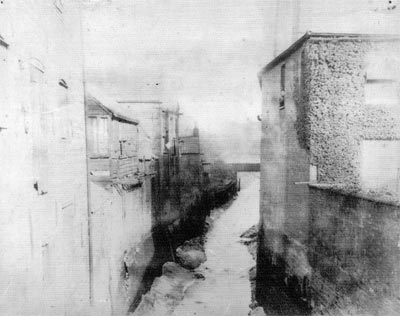 |
Millfleet from Bridge Street c.1880 |
John Wynch miller for a mill leased him with 2 cottages and gardens opposite St. James chapel. (Of the rent, 20s. belongs to the Bishop and 20s. to the Prior of Lynn.) [This would have been the grain mill, whose site was acquired by the town from the Bishop, for an annual farm of 20s., in August 1392. The king’s ratification of this agreement, the following month, indicated the site (to be selected by the burgesses) was to be on Millfleet where Swagges_Mill had once stood, or between that site and the Gannock gate (one of the lesser gates on the east boundary of the town). The burgesses were admonished: not to damage the fleet when excavating for the new mill; not to block the fleet’s course, which ran eastwards to the Bishop’s demesne at Mintling; not to allow the mill to back up water so that floods resulted, as had happened with Swagges_Mill; and to ensure the causeway (raised road) on the north side of the fleet was maintained. Robert Perch miller had leased the mill for three years in July 1424, but he later complained that bakers and others were not bringing corn to him to have it ground; in November the borough released him from the arrangement and leased the mill to Wynch for seven years. Wynch probably encountered the same problem for, in March 1426 the borough issued an order for all bakers to grind their grain at the town mill; but the problem persisted and, shortly after the end of Wynch’s term, the borough passed an ordinance obliging townsmen to take their grain to the town mill. The cottages and gardens had been associated with the farm of the mill since at least 1399.] |
All residents of Lynn, whatever their status, shall have their grain ground at the common mill if the mill is able to handle their demands. Henceforth if anyone has his grain ground at any mill outside of town when the common mill could have ground it, he shall forfeit the grain or the flour produced outside town, which may be confiscated by the common sergeant or someone else and put to the use of the community. |
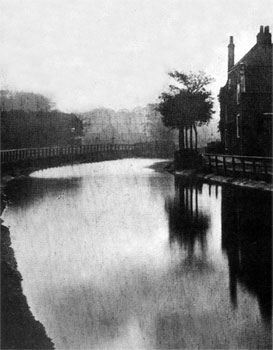 |
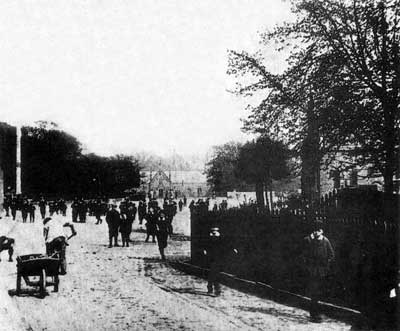 |
Millfleet c.1895 |
Millfleet c.1898 |
The above pair of photographs were taken from the same location, looking upstream towards what later became known as the London Road (note the same tree) with the Almshouses on the far side of the road. The left hand photo shows the Millfleet at high tide; a few hours later at low tide the Fleet would largely consist of smelly mud with virtually no water flow. |
Kings Lynn Corporation was constantly receiving complaints about the sewer-like appearance of the Millfleet and so in 1896, the Corporation borrowed £12,846 to fund the filling in of the Fleet. |
|
...the Town Corn Mill, which stood near the entrance of the Walks, and was driven by the waters of the "Mill" fleet. |
|
1/.VOLll
Page768-768 |
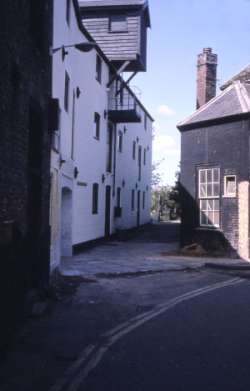 |
Mill Fleet June 1969 |
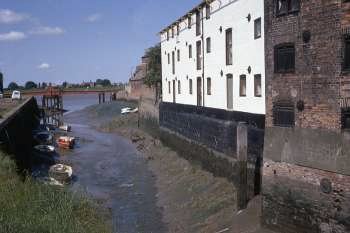 |
Mill Fleet June 1969 |
Thomas Shearman was born in Stowmarket, Suffolk in 1637 and was baptised on 16th July 1637. He was the son of John and Elizabeth Shearman. Thomas married Ann and they had several children including a son, Thomas jnr. In 1667 Thomas Shearing snr was paying 1s hearth tax in Bridgegate, Thetford as he was the owner of two hearths. Thomas Shearing snr was made a Freeman of Kings Lynn in 1691 and died in Thetford in March 1705. Thomas Shearman snr's will signed in 1704, stated that he had a mortgage on a watermill and windmills in Kings Lynn and a watermill in Stowmarket, Suffolk. |
Congregation held on Friday 17 October 1690 |
Lease to Thomas Shearman. The Common seale is likewise affixed to an Indenture of Lease to Thomas Shearman of the Water Corne Mills & Lands adjoining pursueant to Articles of Agreement lately made. And it is ordered It be tendered to him with the Counterpart to be sealed by him. King's Lynn Hall book - 1684-1731 |
Congregation held on Friday 20 March 1660/1 |
Thomas Shearman to be sued. Ordered that Thomas Shearman Miller be forthwith prosecuted at Law & otherwise to inforce his sealing the Counterpart of his Lease and to pay in such moneys as are in his hands. King's Lynn Hall book - 1684-1731 |
Congregation held on Monday 4 April 1692 |
Shearman to be sued at Law for repaire of Cornemills. Ordered that Thomas Shearman Towne Tenant of the Corne Mills and lands be sued at Law to inforce performance of his Covenants as to the Repaires of the Siad Mills & Walls. King's Lynn Hall book - 1684-1731 |
Congregation held on Friday 19 May 1693 |
Committee about the Corne Mills. It is referred to Mr Maior Sir John Turner Mr Sparrow Mr Anderson Mr Frammingham The Chamberlins Mr Harvey and the Towne Clerke or any 3 or more of them to inspect the Covenants in Thomas Shearman's Lease of the Cornemills etc. and to examin how farr hee hath performed the same What has been done at the Town Charge what by the Tenant And what money hath beene or ought to be lent him or allowed him on any Accompt And to certifie theire Opinions therein at next Hall. King's Lynn Hall book - 1684-1731 |
Congregation held on Monday 12 June 1693 |
Sherman's Petition answered. Ordered that twelve pounds be allowed to Thomas Sherman Miller towards his Timber and the Charges of suite mencioned in his Peticion. That £25 formerly lent him be continued in his hand for 6 months on his owne bond, if longer to find other security. And that if hee shall set up & furnish a Windmill hee shall be allowed for the same at the End of his Terme as it shall be indifferently valued. If he shall not longer continue Tenant. King's Lynn Hall book 1684-1731 |
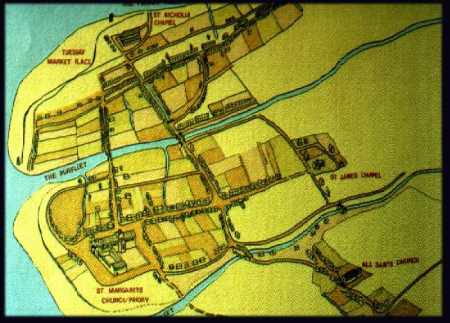 |
Map of Kings Lynn in 1240 |
August 1392: Kings Lynn town acquired the site from the Bishop of Lynn at 20s per annum |
| If you have any memories, anecdotes or photos please let us know and we may be able to use them to update the site. By all means telephone 07836 675369 or |
Copyright © Jonathan Neville 2005 |